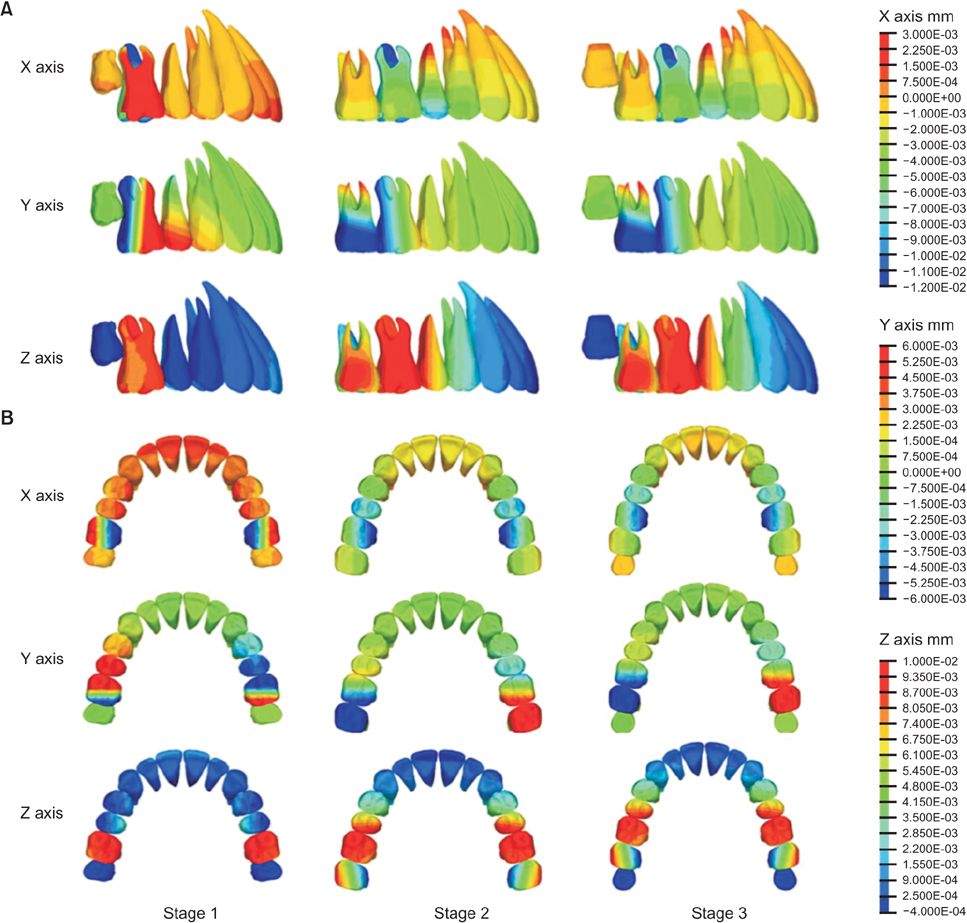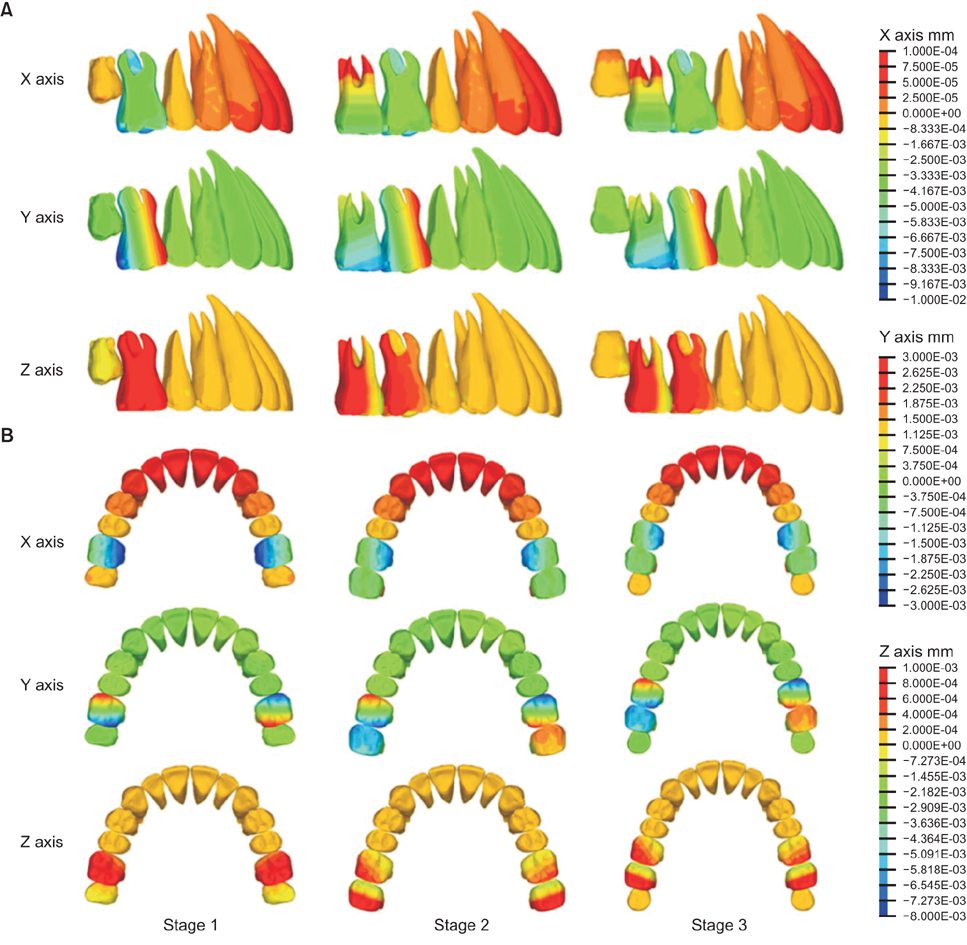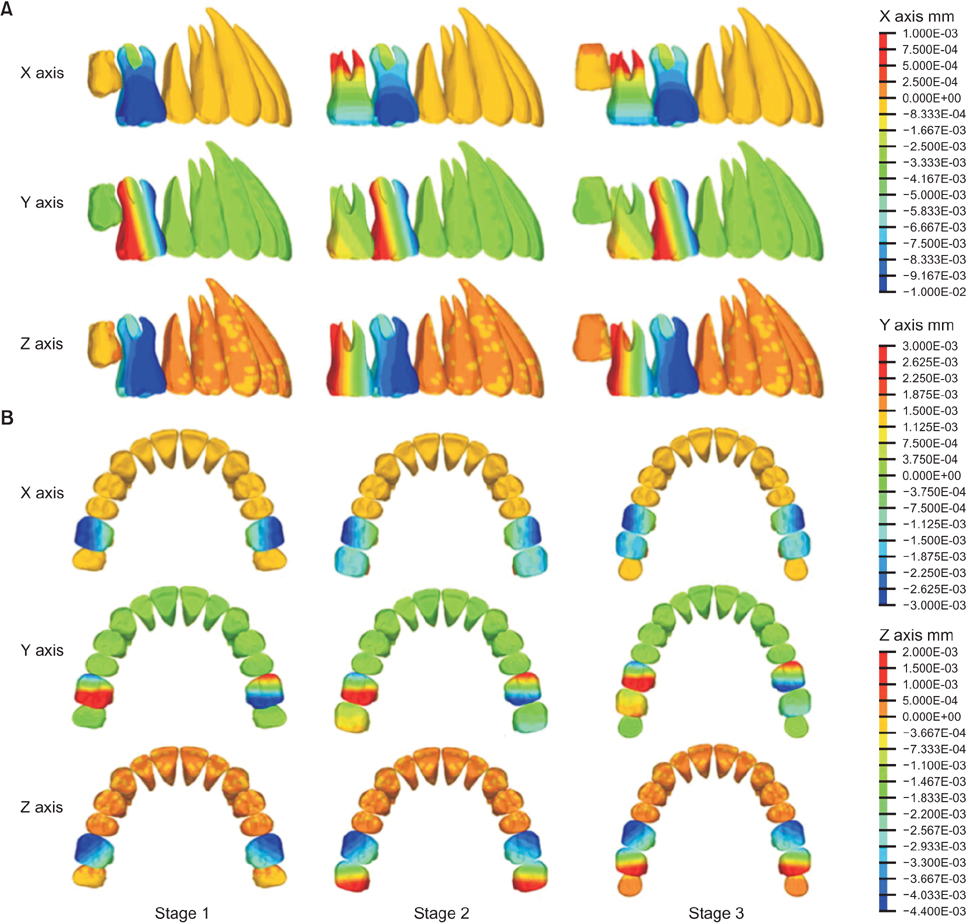Korean J Orthod.
2016 Sep;46(5):290-300. 10.4041/kjod.2016.46.5.290.
A three-dimensional finite element analysis of molar distalization with a palatal plate, pendulum, and headgear according to molar eruption stage
- Affiliations
-
- 1Department of Dentistry, Graduate School, The Catholic University of Korea, Seoul, Korea.
- 2Postgraduate Orthodontic Program, Arizona School of Dentistry & Oral Health, A.T. Still University, Mesa, AZ, USA.
- 3Graduate School of Dentistry, Kyung Hee University, Seoul, Korea.
- 4Department of Postgraduate Studies, the Universidad Autonóma del Paraguay, Asunción, Paraguay.
- 5Department of Orthodontics, St. Mary's Hospital, College of Medicine, The Catholic University of Korea, Seoul, Korea. kook190036@yahoo.com
- 6Private Practice, Seoul, Korea.
- 7Department of Orthodontics, Graduate School of Clinical Dental Science, The Catholic University of Korea, Seoul, Korea.
- 8Department of Orthodontics, School of Dentistry, Seoul National University, Seoul, Korea.
- KMID: 2352291
- DOI: http://doi.org/10.4041/kjod.2016.46.5.290
Abstract
OBJECTIVE
This study aimed to (1) evaluate the effects of maxillary second and third molar eruption status on the distalization of first molars with a modified palatal anchorage plate (MPAP), and (2) compare the results to the outcomes of the use of a pendulum and that of a headgear using three-dimensional finite element analysis.
METHODS
Three eruption stages were established: an erupting second molar at the cervical one-third of the first molar root (Stage 1), a fully erupted second molar (Stage 2), and an erupting third molar at the cervical one-third of the second molar root (Stage 3). Retraction forces were applied via three anchorage appliance models: an MPAP with bracket and archwire, a bone-anchored pendulum appliance, and cervical-pull headgear.
RESULTS
An MPAP showed greater root movement of the first molar than crown movement, and this was more noticeable in Stages 2 and 3. With the other devices, the first molar showed distal tipping. Transversely, the first molar had mesial-out rotation with headgear and mesial-in rotation with the other devices. Vertically, the first molar was intruded with an MPAP, and extruded with the other appliances.
CONCLUSIONS
The second molar eruption stage had an effect on molar distalization, but the third molar follicle had no effect. The application of an MPAP may be an effective treatment option for maxillary molar distalization.
Keyword
Figure
Cited by 2 articles
-
Comparison of treatment effects between the modified C-palatal plate and cervical pull headgear for total arch distalization in adults
Chong Ook Park, Noor Laith Sa'aed, Mohamed Bayome, Jae Hyun Park, Yoon-Ah Kook, Young-Seok Park, Seong Ho Han
Korean J Orthod. 2017;47(6):375-383. doi: 10.4041/kjod.2017.47.6.375.Cone-beam computed tomography-guided three-dimensional evaluation of treatment effectiveness of the Frog appliance
Mujia Li, Xiaoxia Su, Yang Li, Xianglin Li, Xinqin Si
Korean J Orthod. 2019;49(3):161-169. doi: 10.4041/kjod.2019.49.3.161.
Reference
-
1. Gianelly AA. Distal movement of the maxillary molars. Am J Orthod Dentofacial Orthop. 1998; 114:66–72.
Article2. Kinzinger GS, Fritz UB, Sander FG, Diedrich PR. Efficiency of a pendulum appliance for molar distalization related to second and third molar eruption stage. Am J Orthod Dentofacial Orthop. 2004; 125:8–23.
Article3. Karlsson I, Bondemark L. Intraoral maxillary molar distalization. Angle Orthod. 2006; 76:923–929.
Article4. Egolf RJ, BeGole EA, Upshaw HS. Factors associated with orthodontic patient compliance with intraoral elastic and headgear wear. Am J Orthod Dentofacial Orthop. 1990; 97:336–348.
Article5. Lima Filho RM, Lima AL, de Oliveira Ruellas AC. Longitudinal study of anteroposterior and vertical maxillary changes in skeletal class II patients treated with Kloehn cervical headgear. Angle Orthod. 2003; 73:187–193.6. Ghosh J, Nanda RS. Evaluation of an intraoral maxillary molar distalization technique. Am J Orthod Dentofacial Orthop. 1996; 110:639–646.
Article7. Byloff FK, Darendeliler MA. Distal molar movement using the pendulum appliance. Part 1: Clinical and radiological evaluation. Angle Orthod. 1997; 67:249–260.8. Byloff FK, Darendeliler MA, Clar E, Darendeliler A. Distal molar movement using the pendulum appliance. Part 2: The effects of maxillary molar root uprighting bends. Angle Orthod. 1997; 67:261–270.9. Bussick TJ, McNamara JA Jr. Dentoalveolar and skeletal changes associated with the pendulum appliance. Am J Orthod Dentofacial Orthop. 2000; 1(17):333–343.
Article10. Polat-Ozsoy O, Kircelli BH, Arman-Ozçirpici A, Pektaş ZO, Uçkan S. Pendulum appliances with 2 anchorage designs: conventional anchorage vs bone anchorage. Am J Orthod Dentofacial Orthop. 2008; 133:339.e9–339.e17.
Article11. Byloff FK, Kärcher H, Clar E, Stoff F. An implant to eliminate anchorage loss during molar distalization: a case report involving the Graz implant-supported pendulum. Int J Adult Orthodon Orthognath Surg. 2000; 15:129–137.12. Kircelli BH, Pektaş ZO, Kircelli C. Maxillary molar distalization with a bone-anchored pendulum appliance. Angle Orthod. 2006; 76:650–659.13. Papadopoulos MA. Orthodontic treatment of Class II malocclusion with miniscrew implants. Am J Orthod Dentofacial Orthop. 2008; 134:604.e1–604.e16. discussion 604-5.
Article14. Kinzinger GS, Gülden N, Yildizhan F, Diedrich PR. Efficiency of a skeletonized distal jet appliance supported by miniscrew anchorage for noncompliance maxillary molar distalization. Am J Orthod Dentofacial Orthop. 2009; 136:578–586.
Article15. Kaya B, Sar C, Arman-Özçirpici A, Polat-Özsoy O. Palatal implant versus zygoma plate anchorage for distalization of maxillary posterior teeth. Eur J Orthod. 2013; 35:507–514.
Article16. Lee J, Miyazawa K, Tabuchi M, Sato T, Kawaguchi M, Goto S. Effectiveness of en-masse retraction using midpalatal miniscrews and a modified transpalatal arch: treatment duration and dentoskeletal changes. Korean J Orthod. 2014; 44:88–95.
Article17. Nishimura M, Sannohe M, Nagasaka H, Igarashi K, Sugawara J. Nonextraction treatment with temporary skeletal anchorage devices to correct a Class II Division 2 malocclusion with excessive gingival display. Am J Orthod Dentofacial Orthop. 2014; 145:85–94.
Article18. Kook YA, Bayome M, Trang VT, Kim HJ, Park JH, Kim KB, et al. Treatment effects of a modified palatal anchorage plate for distalization evaluated with cone-beam computed tomography. Am J Orthod Dentofacial Orthop. 2014; 146:47–54.
Article19. Sa'aed NL, Park CO, Bayome M, Park JH, Kim Y, Kook YA. Skeletal and dental effects of molar distalization using a modified palatal anchorage plate in adolescents. Angle Orthod. 2015; 85:657–664.20. Yu IJ, Kook YA, Sung SJ, Lee KJ, Chun YS, Mo SS. Comparison of tooth displacement between buccal mini-implants and palatal plate anchorage for molar distalization: a finite element study. Eur J Orthod. 2014; 36:394–402.
Article21. Joseph AA, Butchart CJ. An evaluation of the pendulum distalizing appliance. Semin Orthod. 2000; 6:129–135.22. Flores-Mir C, McGrath L, Heo G, Major PW. Efficiency of molar distalization associated with second and third molar eruption stage. Angle Orthod. 2013; 83:735–742.
Article23. Farnsworth D, Rossouw PE, Ceen RF, Buschang PH. Cortical bone thickness at common miniscrew implant placement sites. Am J Orthod Dentofacial Orthop. 2011; 139:495–503.
Article24. Tanne K, Hiraga J, Kakiuchi K, Yamagata Y, Sakuda M. Biomechanical effect of anteriorly directed extraoral forces on the craniofacial complex: a study using the finite element method. Am J Orthod Dentofacial Orthop. 1989; 95:200–207.
Article25. Yu HS, Baik HS, Sung SJ, Kim KD, Cho YS. Three-dimensional finite-element analysis of maxillary protraction with and without rapid palatal expansion. Eur J Orthod. 2007; 29:118–125.
Article26. Sarrafpour B, Swain M, Li Q, Zoellner H. Tooth eruption results from bone remodelling driven by bite forces sensed by soft tissue dental follicles: a finite element analysis. PLoS One. 2013; 8:e58803.
Article27. Teuscher U. An appraisal of growth and reaction to extraoral anchorage. Simulation of orthodontic-orthopedic results. Am J Orthod. 1986; 89:113–121.
Article28. Jeong GM, Sung SJ, Lee KJ, Chun YS, Mo SS. Finite-element investigation of the center of resistance of the maxillary dentition. Korean J Orthod. 2009; 39:83–94.
Article29. Sung EH, Kim SJ, Chun YS, Park YC, Yu HS, Lee KJ. Distalization pattern of whole maxillary dentition according to force application points. Korean J Orthod. 2015; 45:20–28.
Article30. Fudalej P, Antoszewska J. Are orthodontic distalizers reinforced with the temporary skeletal anchorage devices effective? Am J Orthod Dentofacial Orthop. 2011; 139:722–729.
Article31. Smith RJ, Burstone CJ. Mechanics of tooth movement. Am J Orthod. 1984; 85:294–307.
Article32. Gelgör IE, Büyükyilmaz T, Karaman AI, Dolanmaz D, Kalayci A. Intraosseous screw-supported upper molar distalization. Angle Orthod. 2004; 74:838–850.33. Oosthuizen L, Dijkman JF, Evans WG. A mechanical appraisal of the Kloehn extraoral assembly. Angle Orthod. 1973; 43:221–232.34. Reimann S, Keilig L, Jäger A, Brosh T, Shpinko Y, Vardimon AD, et al. Numerical and clinical study of the biomechanical behaviour of teeth under orthodontic loading using a headgear appliance. Med Eng Phys. 2009; 31:539–546.
Article35. Kook YA, Park JH, Bayome M. Space regaining with modified palatal anchorage plates. J Clin Orthod. 2015; 49:587–595.36. Kook YA, Park JH, Kim Y, Ahn CS, Bayome M. Sagittal correction of adolescent patients with modified palatal anchorage plate appliances. Am J Orthod Dentofacial Orthop. 2015; 148:674–684.
Article37. Kook YA, Park JH, Bayome M, Sa'aed NL. Correction of severe bimaxillary protrusion with first premolar extractions and total arch distalization with palatal anchorage plates. Am J Orthod Dentofacial Orthop. 2015; 148:310–320.
Article38. Baccetti T, Franchi L, Stahl F. Comparison of 2 comprehensive Class II treatment protocols including the bonded Herbst and headgear appliances: a double-blind study of consecutively treated patients at puberty. Am J Orthod Dentofacial Orthop. 2009; 135:698.e1–698.e10. discussion 698-9.
Article39. Shpack N, Brosh T, Mazor Y, Shapinko Y, Davidovitch M, Sarig R, et al. Long- and short-term effects of headgear traction with and without the maxillary second molars. Am J Orthod Dentofacial Orthop. 2014; 146:467–476.
Article40. Lima Filho RM, de Oliveira Ruellas AC. Long-term maxillary changes in patients with skeletal Class II malocclusion treated with slow and rapid palatal expansion. Am J Orthod Dentofacial Orthop. 2008; 134:383–388.
Article41. Varlik SK, Iscan HN. The effects of cervical headgear with an expanded inner bow in the permanent dentition. Eur J Orthod. 2008; 30:425–430.
Article42. Freitas MR, Lima DV, Freitas KM, Janson G, Henriques JF. Cephalometric evaluation of Class II malocclusion treatment with cervical headgear and mandibular fixed appliances. Eur J Orthod. 2008; 30:477–482.
Article43. Caprioglio A, Cafagna A, Fontana M, Cozzani M. Comparative evaluation of molar distalization therapy using pendulum and distal screw appliances. Korean J Orthod. 2015; 45:171–179.
Article44. Angelieri F, de Almeida RR, Janson G, Castanha Henriques JF, Pinzan A. Comparison of the effects produced by headgear and pendulum appliances followed by fixed orthodontic treatment. Eur J Orthod. 2008; 30:572–579.
Article45. Patel MP, Henriques JF, de Almeida RR, Pinzan A, Janson G, de Freitas MR. Comparative cephalometric study of Class II malocclusion treatment with Pendulum and Jones jig appliances followed by fixed corrective orthodontics. Dental Press J Orthod. 2013; 18:58–64.
Article
- Full Text Links
- Actions
-
Cited
- CITED
-
- Close
- Share
- Similar articles
-
- Immediate changes in the mandibular dentition after maxillary molar distalization using headgear
- Evaluation of the effects of the third molar on distalization and the effects of attachments on distalization and expansion with clear aligners: Three-dimensional finite element study
- Biomechanical analysis of distalization of mandibular molars by placing a mini-plate: A finite element study
- Combined treatment with headgear and the Frog appliance for maxillary molar distalization: a randomized controlled trial
- Three dimensional analysis of tooth movement using different types of maxillary molar distalization appliances








